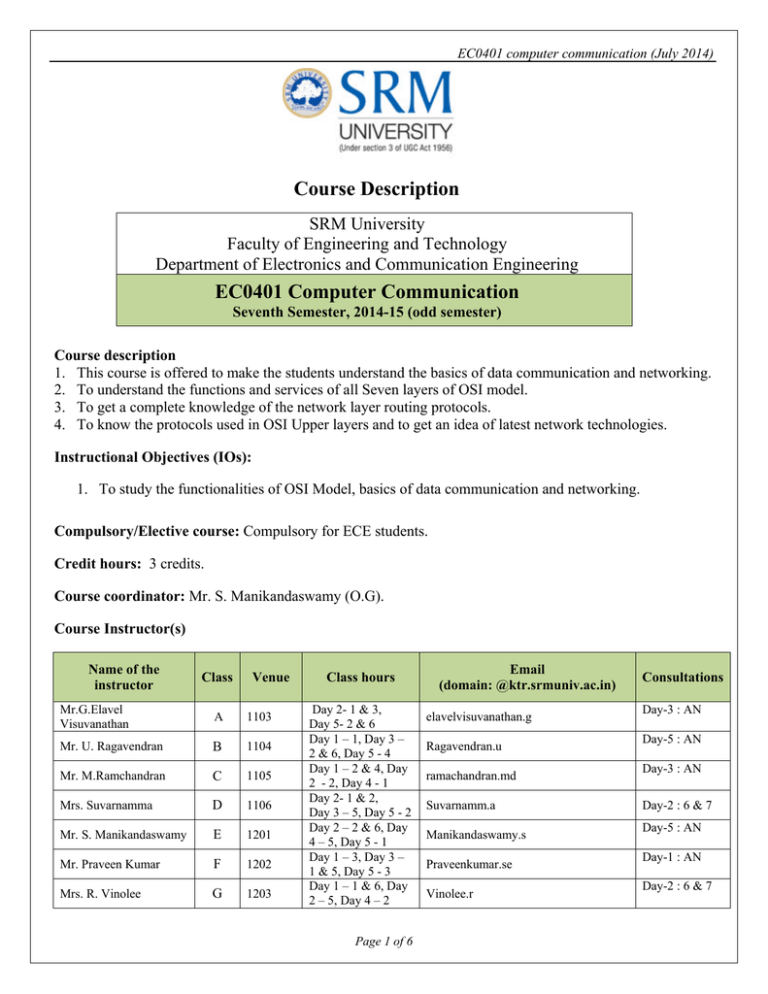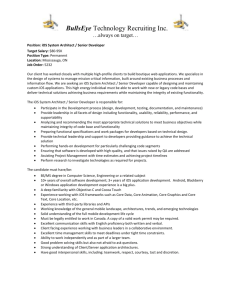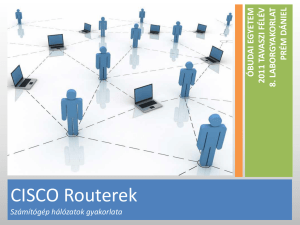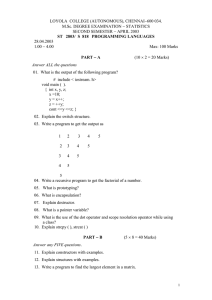Course Description EC0401 Computer Communication
advertisement

EC0401 computer communication (July 2014) Course Description SRM University Faculty of Engineering and Technology Department of Electronics and Communication Engineering EC0401 Computer Communication Seventh Semester, 2014-15 (odd semester) Course description 1. This course is offered to make the students understand the basics of data communication and networking. 2. To understand the functions and services of all Seven layers of OSI model. 3. To get a complete knowledge of the network layer routing protocols. 4. To know the protocols used in OSI Upper layers and to get an idea of latest network technologies. Instructional Objectives (IOs): 1. To study the functionalities of OSI Model, basics of data communication and networking. Compulsory/Elective course: Compulsory for ECE students. Credit hours: 3 credits. Course coordinator: Mr. S. Manikandaswamy (O.G). Course Instructor(s) Name of the instructor Class Venue Mr.G.Elavel Visuvanathan A 1103 Mr. U. Ragavendran B 1104 Mr. M.Ramchandran C 1105 Mrs. Suvarnamma D 1106 Mr. S. Manikandaswamy E 1201 Mr. Praveen Kumar F 1202 Mrs. R. Vinolee G 1203 Class hours Day 2- 1 & 3, Day 5- 2 & 6 Day 1 – 1, Day 3 – 2 & 6, Day 5 - 4 Day 1 – 2 & 4, Day 2 - 2, Day 4 - 1 Day 2- 1 & 2, Day 3 – 5, Day 5 - 2 Day 2 – 2 & 6, Day 4 – 5, Day 5 - 1 Day 1 – 3, Day 3 – 1 & 5, Day 5 - 3 Day 1 – 1 & 6, Day 2 – 5, Day 4 – 2 Page 1 of 6 Email (domain: @ktr.srmuniv.ac.in) elavelvisuvanathan.g Ragavendran.u ramachandran.md Suvarnamm.a Manikandaswamy.s Praveenkumar.se Vinolee.r Consultations Day-3 : AN Day-5 : AN Day-3 : AN Day-2 : 6 & 7 Day-5 : AN Day-1 : AN Day-2 : 6 & 7 EC0401 computer communication (July 2014) Name of the instructor Class Mrs. S.Latha H Venue Class hours Day 1 – 3 & 6, Day 3 – 1, Day 4 – 5 1204 Email (domain: @ktr.srmuniv.ac.in) Consultations Day-5 : AN latha.su Relationship to other courses Pre-requisites : Nil. Assumed knowledge : Basic knowledge in data communication, as well as networking concepts such as TCP/IP protocols. Following courses : EC0403 Wireless Communication, EC0015 Mobile Computing. Text book(s) and/or required materials T1. Behrouz A.Fehrouzan, “Data communication & Networking” Mc-Graw Hill, 3rd edition, 2004. T2. Andrew S.Tanenbaum, “Computer Networks”, 4th edition, Pearson education, 1999. T3. W.Stallings, “Data & computer communication”, 2nd Edition, NY Pearson, 1988. T4. Rarnier Handel, N.Huber, Schroder, “ATM Networks Concepts ,Protocols Applications’’, Addison Welsey, 1999. Computer usage: (if any) Network Stimulation Lab. Detailed Session Plan Session Topics Problem solving (Yes/No) Text / Chapter Correlation of Topics with Instructional Objectives (IOs) & Pgm. Outcomes (POs) IOs Pos 1 Introduction to Data transfer modes No [T1] chapter – 1 1 d, j 2 Telephone system, Protocols & standards No [T1] chapter – 2 1 d, j, k Yes [T1] chapter – 6 1 d, j, k Yes [T1] chapter – 6 1 d, j, k No [T2] chapter – 8 1 d, j, k Yes [T1] chapter – 1 1 d, j, k Multiplexing- FDM 3 4 Multiplexing- TDM &Types 5 Circuit switching, Message & packet switching 6 Introduction to LAN, MAN & WAN Page 2 of 6 EC0401 computer communication (July 2014) Session Topics Problem solving (Yes/No) Text / Chapter Correlation of Topics with Instructional Objectives (IOs) & Pgm. Outcomes (POs) IOs Pos 7 Network topologies Yes [T1] chapter – 1 1 d, j, k 8 IEEE standards for LAN-Ethernet No [T2] chapter – 4 1 d, j, k 9 IEEE standards for LAN-Token Ring & Bus No [T2] chapter – 4 1 d, j, k 10 Introduction to network reference model No [T1] chapter – 2 1 d, j, k 11 OSI layer architecture No [T1] chapter – 2 1 d, j, k 12 OSI seven layer functions No [T1] chapter – 2 1 d, j, k 13 Issues in data traffic over network No [T1] chapter – 23 1 d, j, k 14 Physical layer standards No [T1] chapter – 7 1 d, j, k 15 Data link control–Error Control No [T1] chapter – 10 1 d, j, k 16 Data link control protocol Flow No [T1] chapter – 2 1 d, j, k 17 control- ARQ schemes No [T1] chapter – 11 1 d, j, k No [T1] chapter – 11 1 d, j, k 18 HDLC protocol 19 Need for Internetworking, Addressing Yes [T1] chapter – 19 1 d, j, k 20 Routing Issues No [T1] chapter – 19 1 d, j, k 21 Routing Algorithms Yes [T2] chapter – 5 1 d, j, k 22 Network Layer Protocols- ARP/RARP Yes [T1] chapter – 20 1 d, j, k 23 Internet protocol (IPV4/V6) Yes [T1] chapter – 20 1 d, j, k Page 3 of 6 EC0401 computer communication (July 2014) Session Topics Problem solving (Yes/No) Text / Chapter Correlation of Topics with Instructional Objectives (IOs) & Pgm. Outcomes (POs) IOs Pos 24 Congestion control mechanism No [T1] chapter – 23 1 d, j, k 25 Congestion Control mechanism No [T1] chapter – 23 1 d, j, k 26 Flow control mechanism No [T1] chapter – 11 1 d, j, k 27 TCP/IP model No [T3] chapter – 2 1 d, j, k 28 Transport Layer services, Elements No [T2] chapter – 6 1 d, j, k 29 Transport layer functions & issues No [T2] chapter – 6 1 d, j, k 30 Transport layer Protocol –TCP No [T1] chapter – 22 1 d, j, k 31 Transport layer Protocol –UDP No [T1] chapter – 22 1 d, j, k 32 Session layer functions No [T1] chapter – 1 1 d, j, k 33 Session layer procedure No [T1] Chapter – 24 1 d, j, k 34 Presentation layer functions No [T1] Chapter – 29 1 d, j, k 35 Presentation layer –Security overview No [T1] Chapter – 29 1 d, j, k 36 Comparison of OSI Higher layers No [T1] Chapter – 24 1 d, j, k 37 Introduction to Application layer No [T1] Chapter – 26 1 d, j, k 38 Email No [T1] Chapter – 26 1 d, j 39 FTP No [T1] Chapter – 26 1 d, j 40 HTTP No [T1] Chapter – 27 1 d, j Page 4 of 6 EC0401 computer communication (July 2014) Session Problem solving (Yes/No) Topics Text / Chapter Correlation of Topics with Instructional Objectives (IOs) & Pgm. Outcomes (POs) IOs Pos 41 Introduction to data compression No [T1] Chapter – 28 1 d, j, k 42 Introduction to ISDN No [T4] Chapter – 1 1 d, j 43 Broadband ISDN Features No [T4] Chapter – 1 1 d, j 44 Introduction to ATM Concept No [T1] Chapter – 18 1 d, j 45 ATM Adaptation layers & formats No [T1] Chapter – 18 1 d, j, k Internal assessment Cycle Test – I Cycle Test – II Model Test Surprise Test Attendance - 10 Marks 10 Marks 20 Marks 05 Marks 05 Marks Prepared by: Mr. S.Manikandaswamy Dated: 03/07/2014 Revision No.: 00 Date of revision: NA Page 5 of 6 Revised by: EC0401 computer communication (July 2014) Program Educational Objectives 1. To prepare students to compete for a successful career in Electronics and Communication Engineering profession through global education standards. 2. To enable the students to aptly apply their acquired knowledge in basic sciences and mathematics in solving Electronics and Communication Engineering problems. 3. To produce skillful graduates to analyze, design and develop a system/component/ process for the required needs under the realistic constraints. 4. To train the students to approach ethically any multidisciplinary engineering challenges with economic, environmental and social contexts. 5. To create awareness among the students about the need for lifelong learning to succeed in their professional career as Electronics and Communication Engineers. Program Outcomes a. an ability to apply knowledge of mathematics, science, and engineering. b. an ability to design and conduct experiments, as well as to analyze and interpret data. c. an ability to design a system, component, or process to meet desired needs within realistic constraints such as economic, environmental, social, political, ethical, health and safety, manufacturability, and sustainability. d. an ability to function on multidisciplinary teams. e. an ability to identify, formulate, and solve engineering problems. f. an understanding of professional and ethical responsibility. g. an ability to communicate effectively. h. the broad education necessary to understand the impact of engineering solutions in a global, economic, environmental, and societal context. i. a recognition of the need for, and an ability to engage in life-long learning. j. a knowledge of contemporary issues. k. an ability to use the techniques, skills, and modern engineering tools necessary for engineering practice. Page 6 of 6



